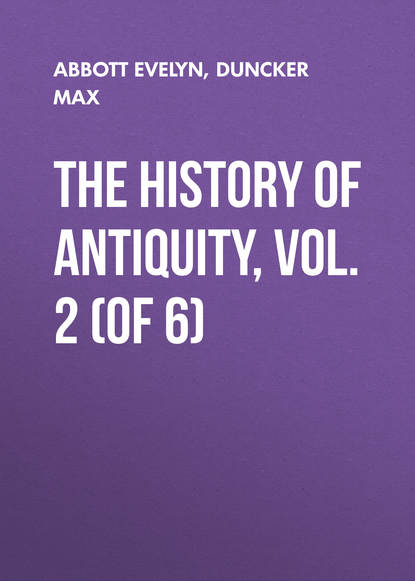По всем вопросам обращайтесь на: info@litportal.ru
(©) 2003-2024.
✖
The History of Antiquity, Vol. 2 (of 6)
Настройки чтения
Размер шрифта
Высота строк
Поля
Nicol. Frag. 8, ed. Müller.
12
1, 184.
13
Strabo, pp. 80, 529, 737; Lucian, "de Syria dea," c. 14.
14
Herod. 1, 102.
15
Xenoph. "Anab." 3, 4, 6-10.
16
Diodorus tells us himself (2, 7) that in writing the first 30 chapters of his second book he had before him the book of Clitarchus on Alexander. Carl Jacoby (loc. cit.) – by a comparison with the statements in point in Curtius, who transcribed Clitarchus, and by the proof that certain passages in the narrative of Diodorus which relate to Bactria and India are in agreement with passages in the seventeenth book, in which Diodorus undoubtedly follows Clitarchus; that certain observations in the description of Babylon in Diodorus can only belong to Alexander and his nearest successors; that certain preparations of Semiramis for the Indian campaign agree with certain preparations of Alexander for his Indian campaign, and certain incidents in Alexander's battle against Porus with certain incidents in the battle of Semiramis against Stabrobates; and finally by showing that the situation of the ancient Nineveh was unknown to the historians of the time of Alexander, who were on the other hand acquainted with a Nineveh on the Euphrates (Hierapolis, Mabog; Plin. "Hist. Nat." 5, 23; Ammian. Marcell. 14, 8, 7) – has made it at least very probable that Diodorus had Ctesias before him in the revision of Clitarchus. We may allow that Clitarchus brought the Bactrian Oxyartes into the narrative, unless we ought to read Exaortes in Diodorus; but that the name of the king in Ctesias was Zoroaster is in my opinion very doubtful. The sources of Ctesias were stories related by Persians or Medes from the epic of West Iran. That this should put Zoroaster at the time of Ninus, and make him king of the Bactrians, in order to allow him to be overthrown by the Assyrians, is very improbable. Whether Ctesias ascribed to Semiramis the building of Egbatana is also very doubtful; that he mentioned her stay in Media, and ascribed to her the building of the road over the Zagrus and the planting of gardens, follows from the quotation of Stephanus given above. Ctesias has not ascribed to her the hanging gardens at Babylon. Diodorus makes them the work of a later Syrian king, whom Ctesias would certainly have called king of Assyria. Ctesias too can hardly have ascribed to her the obelisk at Babylon (Diod. 2, 11); so at least the addition of Diodorus, "that it belonged to the seven wonders," seems to me to prove.
17
"Catasterism." c. 38; Hygin. "Astronom." 2, 41. In Diodorus Aphrodite, enraged by a maiden, Derceto, imbues her with a fierce passion for a youth. In shame she slays the youth, exposes the child, throws herself into the lake of Ascalon, and is changed into a fish. For this reason the image of the goddess Derceto at Ascalon has the face of a woman and the body of a fish (2, 4).
18
Diod. 2, 17, init.
19
Georg. Syncell. p. 119, ed. Bonn.
20
Diod. 1, 56.
21
"De Iside," c. 24.
22
Diod. 2, 4, init.
23
Herod. 1, 7.
24
Lucian, "De Syria dea," c. 33, 14, 38. The name Semiramoth is found 1 Chronicles xv. 18, 20; xvi. 5; 2, xvii. 8.
25
Ctesias in Strabo, p. 785.
26
Agathias, 2, 24.
27
Diod. 2, 21; Euseb. "Chron." 1, p. 56; 2, p. 11, ed. Schöne; Syncellus, "Chron." 1, 313, 314, ed. Bonn; Brandis, "Rer. Assyr. tempor. emend." p. 13 seq.
28
Euseb. "Chron." 1, p. 26, ed. Schöne.
29
1, 184, 187.
30
Vol. i. 512.
31
Ménant, "Annal." p. 18.
32
G. Smith, "Discov." p. 249.
33
The date of Tiglath Adar is fixed by the statement of Sennacherib that he lost his seal to the Babylonians 600 years before Sennacherib took Babylon, i. e. about the year 1300 B.C. As the series of seven kings who reigned before Tiglath Adar is fixed, Assur-bil-nisi, the first of these, can be placed about 1460 B.C. if we allow 20 years to each.
34
Vol. i. p. 262.
35
This series, Pudiel, Bel-nirar and Bin-nirar, is established by tiles of Kileh-Shergat, and the fact that it joins on to Assur-u-ballit, by the tablet of Bin-nirar discovered by G. Smith, in which he calls himself great grandson of Assur-u-ballit, grandson of Bel-nirar, and son of Pudiel; G. Smith, "Discov." p. 244.
36










